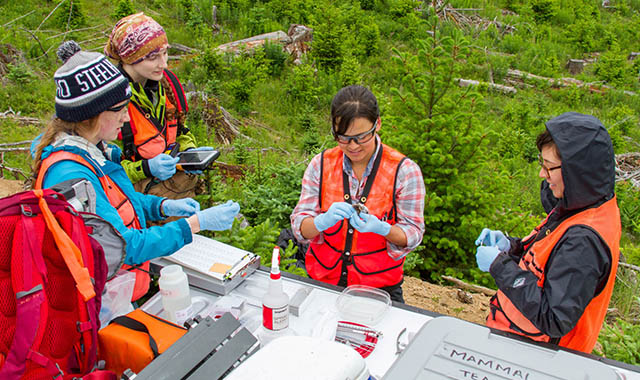Battelle 'Eco Force' Will Soon Fan Across the Country to Support NEON

When 2018 drew to a close, a group of early-career ecologists became part of history by contributing to the establishment of the National Ecological Observatory Network (NEON) that will be collecting ecological data for 30 years, essentially taking the pulse of the continent.
Now, Battelle and the National Science Foundation (NSF) are ramping up by moving into the next phase of the program—full operation of the network located across 81 sites in 24 states and Puerto Rico.
To do so, Battelle needs to hire more than 200 temporary field technicians who typically work from May to September alongside full-time researchers collecting samples and data of flora, fauna, water and air through a series of field-based sampling and collection methods, in addition to a series of instrumented towers and airborne remote sensing platforms.
What’s it like to do this work? It varies. A lot.
Ben Vierra manages the Pacific Northwest domain (NEON divides the country into 20 ecoclimatic domains) that includes aquatic and terrestrial sites. The bulk of the work performed by the 11 temporary field technicians and six permanent staff in his domain occurs during the growing season when plant life is active and there is an uptick in animal and insect life.
On any given day, they may be sent out to collect water samples for chemical analysis, collect invertebrate and algae samples, survey plant diversity, measure tree height and diameter, dig up soil samples or collect beetles, small mammals or mosquitoes. And that is in addition to the associated required lab work.
“The temporary field technicians are well-educated, talented and work hard for a project they find meaningful and hopefully advantageous to advancing their careers,” Ben said.
One of the regions using the largest number of field technicians is in Alaska, where Battelle hired about 40 people last year to assist the nine full-time researchers, said domain field operations manager Chris Baird. This domain—with eight different sites collecting arctic data—has the most to do during the shortest time because the growing season is so short.
The work has its unique challenges with conditions ranging from beautiful, warm, summer days to cold, rainy, snowy days with wind blowing off the sea ice, and getting acclimated to near 24-hour daylight during the summer. Travel is difficult in the remote tundra landscape with limited roads and communication. One would expect polar bears to be a challenge—and they are—but mosquitoes also present another vexing problem.
“They are incredibly dense,” Chris said. “There are swarms of them. Many people are surprised to learn that Alaska collects more mosquitoes than any other site in the observatory network.” The network collects mosquito population data, DNA and pathogen status of mosquitoes across the U.S.
Chris said when hiring the technicians they target college students and recent college graduates in the environmental sciences, biology, ecology, geology and wildlife management. “But we also have some from the humanitarian fields like English who have an interest in science and want to live out in the bush,” he said. “We have some who have come back all three years and they come out with a really well-rounded experience that allows them to do a variety of work that helps them in their decision making on what type of work they ultimately want to pursue.”
Temporary field technician work across the continent falls into three general areas:
Fauna technicians who conduct protocols in the collection of beetles, ticks, mosquitoes and small mammals.
Flora technicians who conduct protocols in plant phenology, plant diversity, herbaceous biomass collections, below-ground biomass, litterfall, canopy foliage, vegetation structure and coarse downed wood.
Aquatic technicians who conduct protocols for surface water chemistry, dissolved gases, isotopes, aquatic microbes, groundwater chemistry, discharge, reaeration, aquatic plants, invertebrates/zooplankton, algae, benthic microbes, sediment chemistry, geomorphology/bathymetry, electrofishing and riparian habitat assessment.
Noelle Tom-Wigfield, who has a degree in wildlife ecology and management from the University of Maryland, has worked a number of seasons at several domains including one in Utah and another in the Pacific Northwest. She said the work is rewarding and there is a strong team mentality.
She takes pride in the over-arching goal of the NEON program. “I’m looking forward to 15 years from now to see where the program is at, especially since it’s still so early right now,” she said. “It’s really exciting to be a part of it.”
Interested applicants can visit www.battelle.org/careers for more information.
BATTELLE UPDATES
Receive updates from Battelle for an all-access pass to the incredible work of Battelle researchers.